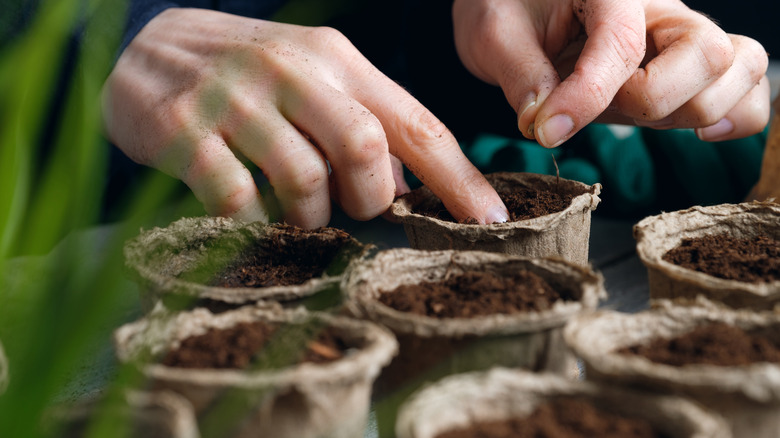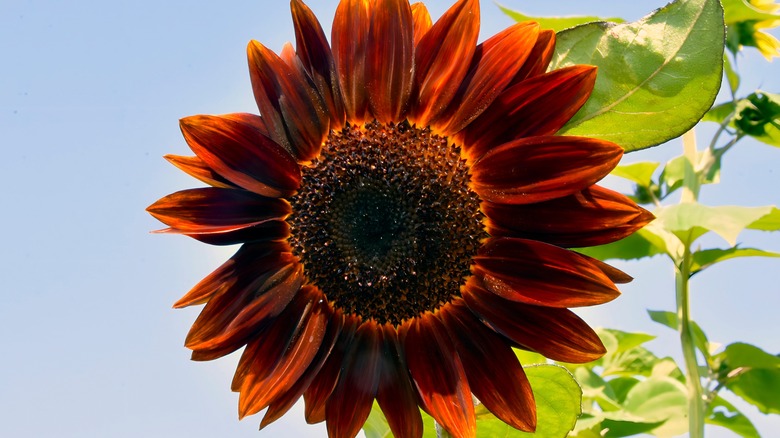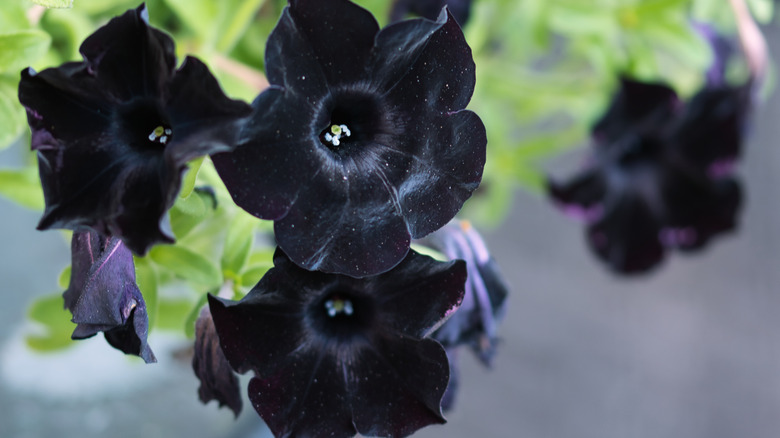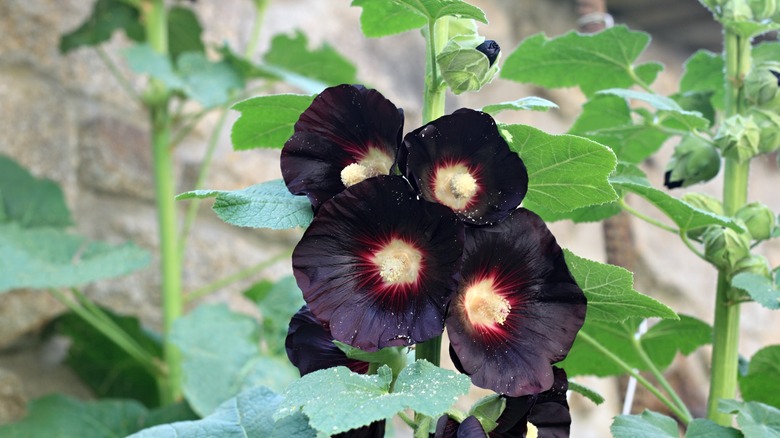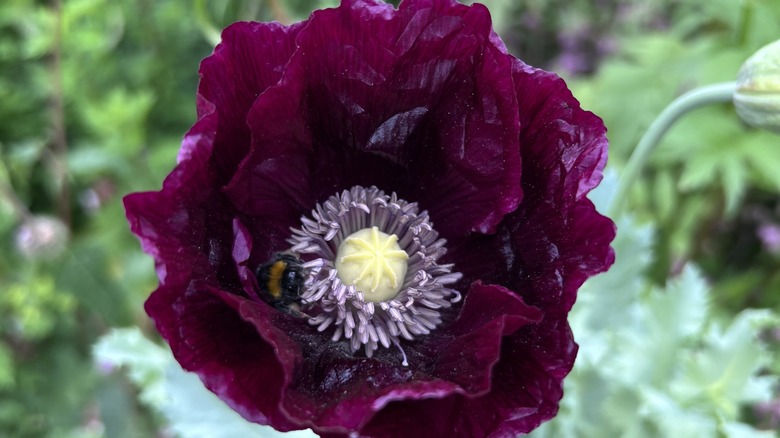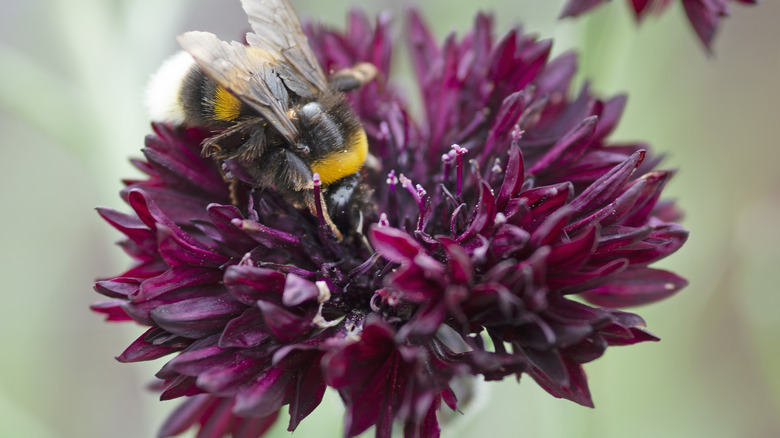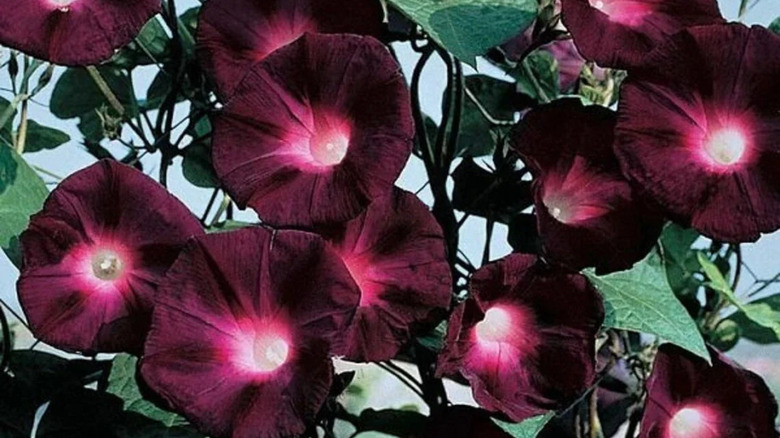6 Stunning Black Flowers You Can Grow From Seed For A Dramatic Garden
There's something about black flowers that lend an air of intrigue to a garden, and yet they occur rarely in nature. Perhaps that's why they're an object of fascination for those who cultivate them. Luckily for gardeners who like a touch of landscaping drama, seed breeders have been creating varieties of black flowers for hundreds of years. Needless to say, quite a few winning cultivars have emerged from these efforts, from black petunias for your container garden to black cornflowers for your cottage garden. A boon for budget-conscious gardeners, many of these flowers are easy to grow from seed.
Everything in nature has a purpose within our local ecosystems. When it comes to flowers, you may already know that bright colors, like yellows and reds, are most attractive to pollinators. So, it may come as no surprise that black flowers, largely a result of seed breeding, draw fewer bees and butterflies, although there are some exceptions. For that reason, black flowers aren't the best plants for your pollinator garden; however, if your aim is to create an ornamental garden that's elegant and unique, these flowers will serve you well.
1. Sweet and sunny chocolate sunflower
Although the word "sunflower" calls to mind bright yellows, there are several of darker varieties available. Case in point: the chocolate sunflower, a type of Helianthus annuus. Darkly hued blooms branch out from plants that grow 4 to 6 feet high. In addition to the standard chocolate sunflower variety, watch out for the chocolate cherry sunflower. As the name suggests, there are hints of red in its dark-brown, almost black, petals.
The recommended seeding method for sunflowers is direct sowing in the ground. Sow seeds in well-draining soil after the last frost. As a branching sunflower type, chocolate sunflowers need room to spread, so plant them about two feet apart. Typical of the species as a whole, their long taproots make transplanting possible, if a bit stressful due to root disturbance. If you go the transplant route, sow seeds in flats, then move them in your garden within two or three weeks. Plants mature in 65 to 75 days.
When left outside to grow, these annuals will draw pollinators and add beauty to your yard. However, they also hold up as cut flowers and can be displayed alone or as part of a summer bouquet. When harvesting, cut the flowers when they're just starting to open. That way you can take fullest advantage of their bloom time.
2. Striking black petunia
While many flowers that appear black in color are actually dark purple or dark brown, the black petunia comes remarkably close to being true black. Not only that, but there are multiple varieties of black petunias. All of these petunias fall under the name of Petunia x hybrida. The Black Mamba, Sweetunia Black Satin, Black Cat, and Black Ray are just some of these. In all cases, the black petunia prefers plenty of sun and well-draining soil. While their ability to survive drier conditions makes a natural choice for container gardens , they also do well in landscapes.
To grow black petunias from seed, follow the instructions on the back of the seed packet, as these may differ slightly by variety. In general, though, you can start seeds indoors and transplant them outside after the last frost. Many gardeners take this approach because petunias can take up to 12 weeks to mature. In other words, starting your seeds indoors allows you to plant them in spring as soon as temps warm up a bit (above 55 degrees Fahrenheit at night).
3. Historical Nigra hollyhocks
It seems the desire for richly colored flowers is nothing new. According to several seed proprietors, the black hollyhock, or Alcea rosea 'Nigra', has been grown in the United States since colonial times, and in Europe before that. Several seed companies quote an English botanist, John Parkinson, as describing the flower in 1629 as "darke red like black blood." While that description may strike some modern gardeners as morbid, what's sure is that the plant presents a dramatic, and lovely, shift from the typical pastels for which the hollyhock is known.
This hollyhock can be sown from seed indoors in late winter, at a depth of 1/8 inch, then transplanted into landscaping beds. They can also be planted directly in your garden after the first frost. Place them in a location in full sun. Hollyhocks grow tall, between 5 and 8 feet. As a result, they're prone to damage from high winds. Provide some shelter for them by adding a trellis or some other supportive or wind-blocking structure.
Hollyhocks are perfect for a cut flower garden, but if you leave them to bloom in the garden, remove flower spikes after they fade. That way, you can gather the seeds for next season. Alternatively, let the seeds fall where they may. Hollyhocks are self-seeders, so you may continue to see these delightful flowers for many seasons to come. Just be sure to thin the volunteer plants when they emerge to give plants sufficient space to grow.
4. Symbolic midnight poppy
Midnight poppy, or Papaver somniferum, is a gorgeous deep purple—almost black—variety of the familiar poppy. For many, the poppy symbolizes peace and remembrance. In the United Kingdom, it's common for people to don poppy pins in November in honor of soldiers who perished in World War I. According to the BBC, the black poppy, specifically, commemorates the sacrifices of black, African, and Caribbean people. Whatever their symbolic meaning, this flower is one that's as easy to grow as it is easy on the eyes.
Typical of poppies, the midnight poppy can thrive in poor soil. Plant them in spring by direct sowing or starting them indoors. Poppies require a period of cold to bloom, so sowing them in early spring with temps are still somewhat low may be sufficient. However, when starting seeds indoors, it's a good idea to do cold seed stratification. Seeds should be kept moist until they emerge, however once established, they require minimal water. The result is a flower that's incredibly low maintenance and will often self-seed, so you can enjoy your poppies for years to come.
5. A black twist on blue cornflower
If you like black cornflowers (Centaurea cyanus), you'll be glad to know there are multiple almost-black varieties available, all of which can be grown from seed. Choose from Double Black, with its double blooms; Black Gem, with its complementary silver foliage; Almost Black, an heirloom variety; or Black Ball, a deep burgundy-colored flower. These hardy annuals resemble their periwinkle-colored cousins in that they tolerate drought and poor soils. A touch lighter than true black, they are visible to pollinators and serve as a food source for them.
Follow the instructions on the seed packet when planting, as there may be slight differences between cultivars. In general, you can sow them directly in early spring and continue to sow throughout the season to enjoy more flowers throughout the season. Sow in late fall for flowers that will emerge the following year.
It's probably no surprise that cornflowers look nice in a cut flower arrangement or even dried. What may be less well known is that these are delicious edible flowers. They make a colorful addition to salads. However, be sure to shake them vigorously to dislodge any small insects and give them a wash before eating, just as you would do with any produce. Deadhead spent flowers to encourage re-blooming throughout the season.
6. Knowlians black morning glory
Similar to many so-called black flowers, Knowlians black morning glory is a very deep purple. Like all morning glories, these flowers open their blooms in the early part of the day, then close as the afternoon sets in. In light of this, one trick is to plant them in part shade in order to coax the flowers to stay out a little longer.
Morning glory seeds have a hard covering, so it's recommended to score the seeds or soak them overnight before planting. This increases the success rate of germination. For best results, you can sow seeds directly in the ground once the soil warms up above 70 degrees. You can also start them indoors a few weeks before the last frost, but beware that transplanting morning glories can cause damage to their roots. Keep the seedlings watered until they're established. After that, they're incredibly low-maintenance. Knowlians grows more slowly than other varieties, taking about 90 to 100 days to bloom; however, once it does, sometime in late summer, it will produce flowers until the frost sets in.
Morning glories are climbers, so plant these vines where they can reach for the sky against a fence or a trellis. Even better, situate them in view of a porch or patio so you can sit and watch the butterflies and hummingbirds that this plant attracts.
